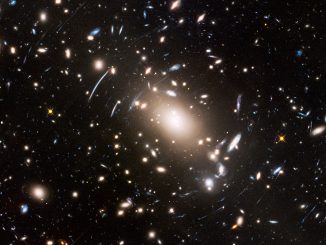
Studying the site of a presumed tidal disruption event in which a passing star was ripped apart by a black hole’s enormous gravity, astronomers have found what appears to be the best evidence yet for an intermediate-mass black hole, a long-sought “missing link” between stellar-mass holes and the supermassive gravity wells at the cores of large galaxies.
The black hole in question has about 50,000 times the mass of the Sun. That’s far more than what might be expected of a black hole formed in the wake of a single supernova blast but far less than the millions to billions of solar masses found in supermassive black holes.
NASA’s Chandra X-ray Observatory and the European Space Agency’s X-ray Multi-Mirror Mission both detected a powerful X-ray flare in 2006. Researchers tentatively attributed the burst, catalogued as 3XMM J215022.4−055108, to a tidal disruption event, but were unable to determine if the flare originated inside or outside the Milky Way.
Enter the Hubble Space Telescope. Dacheng Lin of the University of New Hampshire used Hubble to collect high-resolution imagery showing the flare occurred in a star cluster on the outskirts of another galaxy.

The cluster may be the sparsely populated core of a dwarf galaxy that has been disrupted by gravitational interactions with the larger galaxy, providing the sort of environment conducive to the development of an intermediate-mass black hole, or IMBH.
The mass estimate of 3XMM J215022.4−055108 was based on the X-ray luminosity and spectra, which evolved in a manner consistent with well-understood black hole accretion processes.
“Intermediate-mass black holes are very elusive objects, and so it is critical to carefully consider and rule out alternative explanations for each candidate,” said Lin. “That is what Hubble has allowed us to do for our candidate.”
A paper describing the research was published in the 31 March issue of The Astrophysical Journal Letters.



